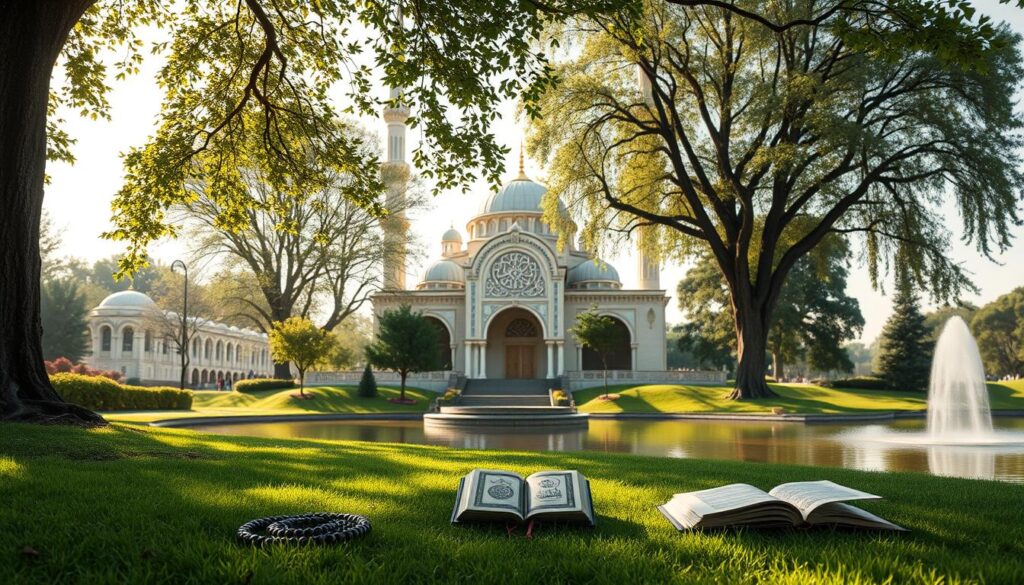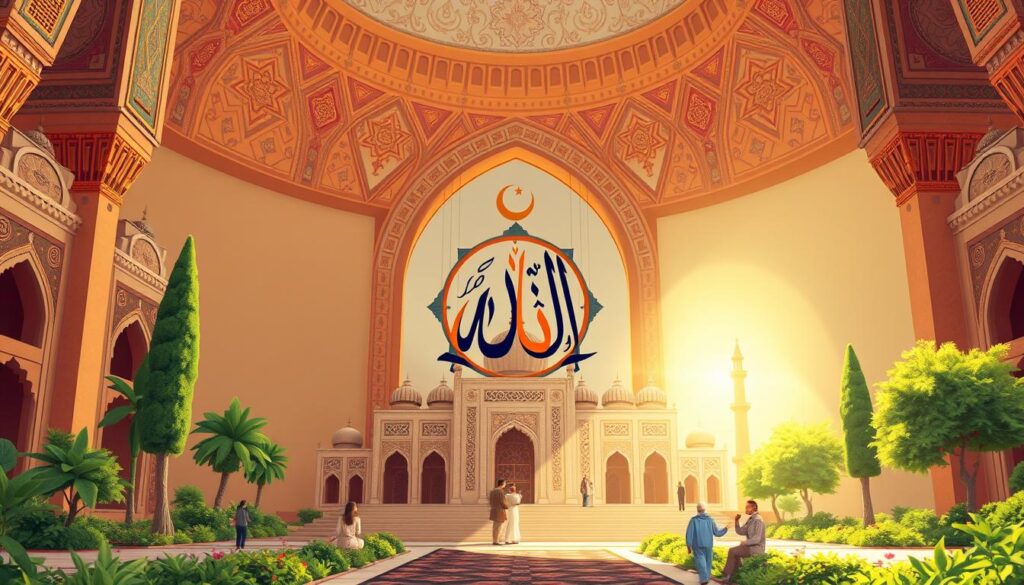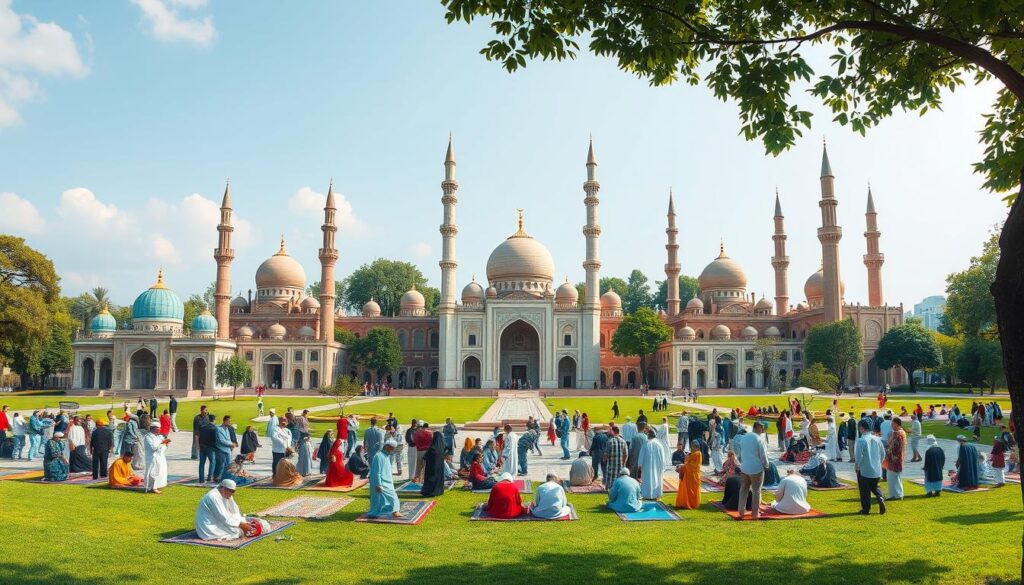Exploring muslim religion sects is fascinating. It’s important to know about the different islamic denominations. These groups, like sunni and shia, have their own beliefs and practices.
Welcome to checkreligion.com
Muslim Religion Sects !
These differences come from history, beliefs, and culture. Learning about the different sects in islam shows the richness of Islamic tradition. It also shows how these differences affect our world today.
Key Takeaways
- Understanding the diversity within muslim religion sects enriches knowledge of Islamic practices.
- The primary groups include sunni and shia, each with unique beliefs.
- Different sects in islam contribute to cultural variations and interpretations.
- These divisions have historical roots worth exploring for better context.
- Modern society is impacted by the ways these sects interact and coexist.
Understanding the Basics of Islam

Islam is a rich and complex faith. It offers a deep understanding of life and spirituality. Founded in the 7th century, it believes in one God, Allah.
The Quran and the Prophet Muhammad’s teachings guide millions. These teachings are the heart of Islam.
What is Islam?
Islam means “submission” or “surrender.” It’s about following God’s will. Muslims follow the Quran and the Hadith, the Prophet Muhammad’s sayings and actions.
These texts shape Muslim lives. They guide their beliefs and rituals.
Core Beliefs and Practices
Islam has key beliefs that all followers accept. These include:
- Tawhid – Believing in one God, Allah.
- Belief in Prophets – Recognizing messengers like Moses and Muhammad.
- Angels – Believing in supernatural beings created by Allah.
- Day of Judgment – Thinking all will be judged for their actions.
- Faith (Iman) – Trusting in God’s wisdom and Islam’s teachings.
The five pillars of Islam are essential practices. They are:
- The Shahada – Declaring faith.
- Prayer (Salah) – Five daily prayers.
- Charity (Zakat) – Giving to those in need.
- Fasting (Sawm) – Fasting during Ramadan.
- Pilgrimage (Hajj) – Visiting Mecca at least once.
Learning about Islam helps us understand Muslim life. These beliefs and practices shape faith and community.
Overview of Major Sects within Islam
Islam is a big and diverse religion. It has many major Islamic sects that are important worldwide. The Sunni and Shia divisions are key because of their long-standing differences.
These differences help us see the wide range of Islamic denominations. They all play a big role in the faith.
Sunni and Shia: The Largest Sects
The Sunni and Shia split started over who should lead after the Prophet Muhammad died in 632 CE. This disagreement has grown into different beliefs and practices over time. Sunnis make up about 85-90% of Muslims, focusing on community and following the Prophet’s teachings through scholars.
Shia Muslims, about 10-15%, believe in a more structured Islam. They think leadership should stay in the Prophet’s family, like Ali. This difference has led to political and conflict issues, showing the variety in Islam.
Other Notable Islamic Denominations
There are more Islamic denominations besides Sunni and Shia. These include:
- Ibadi: Mainly in Oman, they take a balanced and independent stance.
- Ahmadiyya: Started in the late 19th century, they offer a fresh view of Islam but face challenges.
- Sufism: Not really a sect, Sufism is about Islam’s spiritual side, using poetry and music.
| Denomination | Percentage of Global Muslims | Key Beliefs |
|---|---|---|
| Sunni | 85-90% | Community-centered leadership; emphasis on the Quran and Hadith. |
| Shia | 10-15% | Leadership should be through the Prophet’s family; importance of Imams. |
| Ibadi | Less than 1% | Moderate approach; independent from Sunni and Shia practices. |
| Ahmadiyya | Less than 1% | Modern interpretations of Islam; belief in a promised messiah. |
Exploring the Differences: Sunni and Shia

The Sunni and Shia Islam differences go beyond just beliefs. Knowing the history helps us see how these groups formed and changed. Their views on leaders and practices come from big events after the Prophet Muhammad died.
Historical Context
Disputes over who should lead the Muslim community started soon after the Prophet Muhammad died in 632 CE. Sunnis chose leaders through election. But Shia Muslims thought the Prophet’s family should lead, focusing on Ali, his cousin and son-in-law.
This split changed Islamic history and shaped who believers are today.
Key Beliefs and Practices
Sunni Islam values the community’s say in faith matters, relying on scholars’ consensus. Shia Islam believes in leaders called Imams, who have special spiritual power. Their rituals, like mourning in Muharram, remember Imam Hussein’s death.
Current Demographics
Looking at Sunni and Shia numbers shows big differences worldwide. About 85-90% of Muslims are Sunni, and 10-15% are Shia. Iran is mostly Shia, while Saudi Arabia and Egypt are Sunni.
Knowing these numbers helps us see how these groups interact and influence each other.
| Sect | Beliefs | Practices | Demographics (%) | Main Regions |
|---|---|---|---|---|
| Sunni | Elected leadership, consensus-based interpretation | Community prayers, five pillars of Islam | 85-90 | Saudi Arabia, Egypt, Turkey |
| Shia | Leadership through Imams, family-based succession | Mourning rituals, significance of Ashura | 10-15 | Iran, Iraq, Bahrain |
Different Sects in Islam: An In-depth Look
Islam has many sects and views. This part looks at Sufi Islam, Shia groups like Twelvers and Ismailis, and others. We also explore Ahl al-Hadith and minor sects.
Overview of Sufi Islam
Sufi Islam is a mystical part of Islam. It focuses on personal experiences and inner peace. People practice rituals, meditation, and dance to connect with the divine.
Some people think Sufism is not true Islam. But it’s loved for its deep spirituality and cultural impact.
Shia Branches: Twelvers and Ismailis
The Shia tradition has two big groups: Twelvers and Ismailis. Twelvers believe in twelve Imams, who are Muhammad’s family. They think these Imams guide the community.
Ismailis split from Twelvers after the sixth Imam. They have their own ways of thinking and doing things. Both groups show how Shia Islam is diverse.
Ahl al-Hadith and other Minor Sects
Ahl al-Hadith focuses on following the Prophet Muhammad’s sayings. They want to keep traditions alive. There are also many small Islamic groups.
Each group has its own beliefs and ways of doing things. Learning about these groups helps us see the variety in Islamic thought.
Variations within the Muslim Religion

Looking into the Muslim religion shows a wide range of beliefs and practices. These are shaped by where people live and their culture. Each group has its own ways, blending with Islamic teachings.
This mix shows how diverse Islam is, making it a global faith.
Regional Differences in Practice
Worldwide, Islamic practices vary due to where people live. For example, prayer styles differ greatly. In Southeast Asia, people often pray for specific wishes.
In the Middle East, Ramadan prayers are special and different. These changes show how local traditions meet Islamic teachings.
Cultural Influences on Islamic Beliefs
Culture deeply affects how Muslims practice their faith. In North Africa, music and dance are part of celebrations. But in more strict places, these might not be allowed.
These cultural touches make faith unique. They help Muslims feel connected to their community.
Modernity and Interpretation of Faith
Modern times change how Muslims see their faith. Global ideas mix with old traditions. This leads to new views on gender and technology in prayer.
New ideas come up as people try to fit their faith with today’s world.
The mix of regional practices, cultural influences, and modern views makes Islam rich. This invites us to learn more about this major world religion.
Muslim Religion Sects and their Social Impact
Understanding Muslim sects shows us how complex communities and governance can be. Each sect has its own views on social norms and how to organize. This shapes how communities work together.
How groups interact shows both conflict and cooperation. This greatly affects how societies are governed.
Impact on Communities and Governance
Muslim sects have a big impact on local governance. They focus on different things, leading to unique ways of organizing society. In many places, which sect you belong to can affect your access to things like resources and political power.
- Community Mobilization: Different sects work together to improve education and healthcare.
- Political Representation: Some sects have more say in politics, shaping laws and policies.
- Resource Distribution: Resources are often divided along sectarian lines, affecting people’s lives and social bonds.
Inter-sect Relations and Dialogue
Good relations between sects are key to peace in diverse communities. Dialogue helps bridge gaps, fostering understanding and respect. It can reduce tensions and open doors for working together in areas like education and welfare.
“O mankind, indeed We have created you from male and female and made you peoples and tribes that you may know one another.”
In short, understanding Muslim sects is crucial for community and governance. As we seek unity, dialogue is vital for peaceful relations between sects in Islam.
Historical Development of Islamic Denominations
The history of Islamic sects is complex. It shows a mix of beliefs, practices, and events. These started with early disagreements over Islamic texts and leadership.
These divisions led to different sects. Each sect has its own path and followers.
Early Schisms and Their Outcomes
Early Islamic schisms were key. They set the stage for today’s diverse Islamic world. The main split was over who should follow the Prophet Muhammad.
This led to the Sunni and Shia divide. Debates over authority and legitimacy still exist today. The Battle of Karbala made these differences clearer.
After that, groups like the Sufis emerged. They saw Islam in their own way.
The Role of Political Power in Sect Formation
Politics played a big role in sects. The Umayyad Caliphate’s rise changed things a lot. It favored Sunni beliefs.
The Abbasid Caliphate was more open but still influenced sects. This led to some sects gaining power and others being left out. It shows how faith and power are linked in Islamic history.
| Sect | Origins | Key Characteristics | Current Influence |
|---|---|---|---|
| Sunni | Succession post-Muhammad | Emphasizes consensus (ijma) | Majority sect (approx. 85-90% of Muslims) |
| Shia | Dispute over leadership | Recognizes Imams as religious leaders | Strong political and cultural influence in Iran and Iraq |
| Sufi | Mystical interpretations | Focus on personal experience of God | Important in spiritual practices across various sects |
| Ibadi | Origins in early dissent | Moderate and pragmatic beliefs | Significant presence in Oman |
The Future of Muslim Branch Divisions
The world of Islam is changing. This is because of things like more people, young folks getting involved, and the world getting smaller. We need to look at how sects are doing, how they relate to other faiths, and if they can come together.
Trends in Sect Membership
Young people are now more interested in different sects of Islam. They want to find their spiritual home. More people are switching sects, showing that different beliefs are okay.
People moving to new places also changes things. It brings new faces to old communities. This can shake up how sects work together.
Interfaith Efforts and Globalization
More groups are talking to each other to understand each other better. The world getting smaller helps us meet and work together. This can help us solve problems and get along better.
Prospects for Unity within Islam
Can different Muslim groups find common ground? Despite their differences, they are starting to talk and understand each other. This could lead to a stronger, united Islam.
Conclusion
Looking back at what we’ve learned, Islam is very diverse and complex. Each group, like Sunni and Shia, adds its own view to the Muslim world. Knowing these differences helps us understand and value the rich variety of Islam.
There’s hope for unity among these groups. Even though they have their own stories, beliefs, and cultures, we can still talk and come together. It’s key to respect and understand each other to build unity in Islam.
This is a call to keep learning and exploring Islam’s many beliefs. By diving into these differences, we can see the importance of each group. I hope to encourage you to dive into this fascinating world and see how faith can bring us together, even with our differences.
FAQ
What are the different sects in Islam?
Islam has two big groups: Sunni and Shia. There are also Ibadi and Ahmadiyya. Each group sees Islam in their own way.
What are the major beliefs that differentiate Sunni and Shia?
Sunnis pick leaders by the community. Shia believe leaders should be from the Prophet’s family, like Ali.
How do regional practices affect the variations in the Muslim religion?
Local customs shape how Muslims practice. This makes Islam diverse across cultures.
What role do politics play in the formation of sects within Islam?
Politics, like Umayyad and Abbasid rivalries, shaped sects. These events influenced beliefs and identities.
What is the significance of Sufism in the context of Islamic sects?
Sufism focuses on mysticism and personal faith. It’s seen as a key part of Islamic spirituality.
Are there ongoing efforts for dialogue among different Islamic sects?
Yes, many efforts aim to unite different Muslim groups. These dialogues help bridge gaps and promote unity.
How might globalization impact the future of Islamic sects?
Globalization could change how young people see their faith. It might lead to new ways of understanding Islam and more unity.

